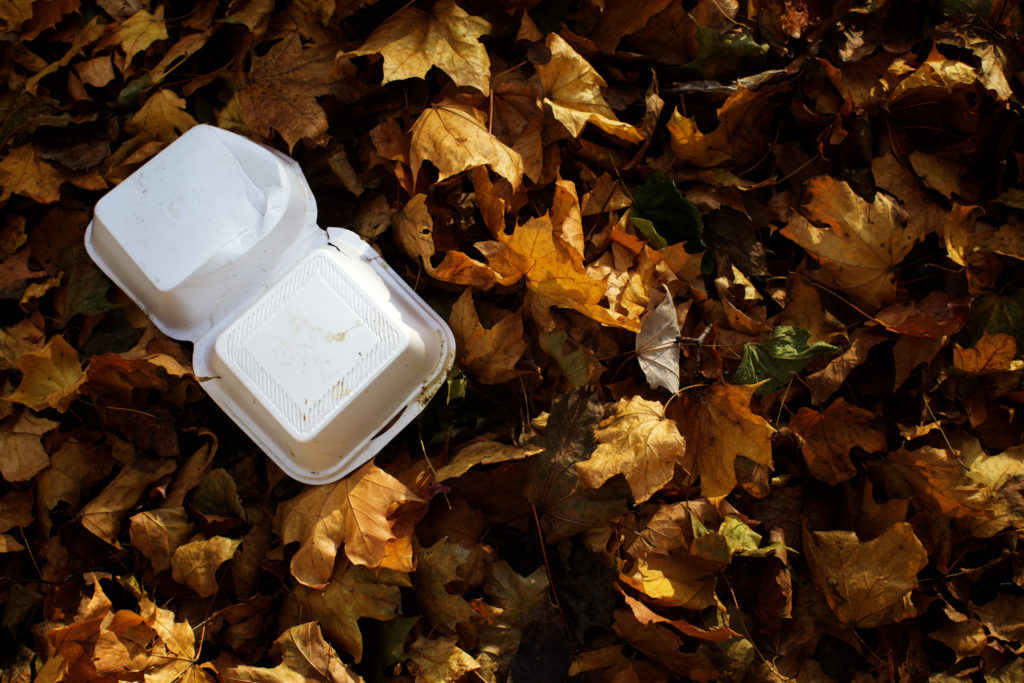7 ways to reuse polystyrene

Maybe you have just received takeout in disposable foam containers or a package filled with packing peanuts. You may be wondering what to do with all that extra polystyrene. It’s not as simple as tossing it your recycling bin, even if it has that tell-tale triangle on the bottom.
If you are scratching your head trying to figure out what polystyrene is in the first place, you might know it by another name: Styrofoam, which is actually the brand name for a specific kind of insulation manufactured by Dow Chemicals. Styrofoam is made of expanded polystyrene, a light synthetic plastic.
Expanded polystyrene, or EPS, is commonly used in single-use coffee cups, food trays, coolers and different types of packaging material.
EPS is cheap, lightweight and useful, but it is also potentially dangerous. The main component of polystyrene is a chemical called styrene, which has the U.S. National Toxicology Program has flagged as a potential human carcinogen. If left in landfills to deteriorate, styrene can leach out and contaminate local ecosystems.
Some EPS products are labeled with a 6 inside the international recycling symbol. The technology to recycle polystyrene exists, but many recycling facilities still do not accept the material. Facilities that recycle EPS often operate at a loss due to contamination and density of the material.
EPS is often used in food and drink containers. Not only can organic matter contaminate recyclables and render them unusable, but EPS is porous and difficult to clean.
Most recycling bales are also sold by weight. Polystyrene foam is also mostly air, but it still takes up a fair amount of space, so it is not cost-effective to store, ship or purchase.
You can call your local recycling center and ask if they accept polystyrene or #6 plastics, or use a search engine like Earth911 or Foam Facts to find out whether there is a polystyrene recycling drop-off site by you.
If all else fails, you can upcycle it in many useful ways around the house instead of tossing the foamy, potentially-toxic plastic that takes hundreds of years to decompose. Aside from reusing it as packing materials, here’s how to reuse polystyrene sheets, cups, packing peanuts and more when it starts to pile up.
Drainage for potted plants
Potting soil is expensive. Save money on gardening supplies for your container garden by adding packing peanuts or other broken-down pieces of polystyrene to the bottom of your pots before you add soil. This should not compromise the health of the plant as long as the soil is deep enough — at least six inches should do — though it is generally recommended that you only use this hack for decorative plants, not edible crops.
Glue
Polystyrene can be dissolved into a simple household glue for crafts. All you need is liquid acetone and a glass, metal or ceramic dish (just like it dissolves EPS, acetone will dissolve plastic bowls).
Pour acetone into the dish. Place your polystyrene scraps in the liquid and press down gently until it dissolves into a gooey liquid — that’s your glue. Continue until no more pure liquid acetone remains. Use the glue immediately or store it in an airtight glass or metal container filled with acetone (the glue will dry out otherwise).
Stuffing
If you are making a DIY pillow from an old t-shirt or looking to refill leaky stuffed animals, use packing peanuts or pieces of broken polystyrene instead of buying new stuffing from a craft store. The pillow or stuffed animal will retain its shape well, but might be less cuddly that stuffing-filled counterparts and should only be spot-cleaned.
Seedling starters
If you have a bunch of polystyrene cups floating around from your last office party, use them to start seeds for non-edible plants. Poke a few drainage holes in the bottom of the cups, add potting soil and seeds and place in a nice sunny spot until the seedlings are large enough to transplant to larger containers.
Insulation (with discretion)
Polystyrene sheets are great to cover and insulate garage windows during the winter, or for extra insulation in season extenders like greenhouses. High-density polystyrene also makes great winter insulation for beehives.
A warning: polystyrene is highly flammable unless it is treated with a flame retardant, so do not upcycle polystyrene sheets as insulation in the bedrooms, living rooms and the like.
Perlite substitute
Perlite is used to promote drainage, aeration and healthy roots in growing mediums used for container gardening or growing seedlings. If you are making your own soilless mix for non-edible plants, you can substitute perlite with firm polystyrene, like the kind used for meat trays from butchers. Thoroughly clean and cut the polystyrene into small squares with sharp scissors. Put the pieces in a blender with enough water so that the foam floats near the top. Blend for about a minute. Drain the mixture, and you have a light and airy Perlite substitute. Mix with equal parts sphagnum peat moss to make your own soilless potting or seedling mix.
Cooling
Polystyrene coolers are effective because EPS is a poor heat conductor. Heat passes through the material very slowly, as the millions of tiny air bubbles intermixed with the foamy hydrocarbon slow its progress. Even if you do not use a polystyrene cooler, you can still take advantage of this property by putting packing peanuts in your cooler with ice to keep things extra cool.
What do you do with the polystyrene you have floating around? Tell us in the comments below.
